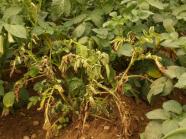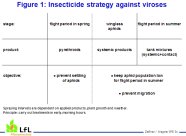
How to avoid virus infestation in seed potato production

potato tuber with virus infestation
The most important defence against viruses is a cautious nitrogen fertilizing, the removal of sources of infection inside and outside of seed potato fields as well as large fields. Insecticides can only play a small part in controlling non-persistent viruses.
Viruses consist of nucleic acids and proteins. They don’t have a metabolism of their own and they can reproduce and spread in their particular host. By disturbing their host’s metabolic processes they interfere with its growth and crop yield. The extent of yield reduction is determined by the species and the number of viruses present in the standing crop. In Bavaria the Potato leafroll virus (PLRV) and the different strains of the Potato virus Y (PVY) are of particular economic importance. Both virus-borne diseases are transmitted by aphids. That is why in years with a high aphid population the infestation rate with viruses is especially high. Mainly seed potato farmers have to put up with considerable financial penalties if the virus level exceeds assessed standards for seed stock.Viruses causing plant diseases can not be controlled directly. For this reason chemical control measures focus on the virus vectors, the aphids. Because of differences in transmitting, persistent and non-persistent viruses are distinguished here.
Good effect on Potato leafroll virus
The leafroll virus belongs to the persistent viruses. It can only be absorbed from the phloem (sieve tubes) after sucking for 1-2 hours. Not until a longer period of circulation inside the aphid, during which the virus moves from the intestine to the salivary, it can be passed on again. It is assumed that between absorbing and successfully transmitting the virus to healthy plants it takes 2-3 days. This is a long time period during which the aphid can get in contact with insecticides, protecting the potatoes. So with this type of transmission a good effect can be achieved on controlling the vectors.
More difficult with Y-virus
Much more important than the leafroll virus are the different strains of the Y-virus. This potato virus belongs to the non-persistent viruses as do A, M and S. To absorb this virus a superficial and short-time piercing of a diseased potato plant is enough. Contact with the phloem is not necessary. When the aphid moves to another plant the virus located on the sucking mouthpart (stylet) can be transferred just as quickly and then infects the plant. In general to take up the virus and to pass it on only 30 seconds or a single short piercing is necessary. This basic difference of transmitting the virus between the leafroll and the Y-virus is the reason for the different success in controlling them with insecticides. The effective period of all for potatoes registered insecticides is sufficient to kill the aphids before they can transmit the leafroll virus. On the contrary the Y-virus, being transmitted short termed, can be transferred even with a consistent protection with insecticides, as the infection of a plant can take place before the aphid is killed or at least paralyzed. The aphid is still able to pierce several plants and infect them. If the aphids absorb non-toxic doses of the insecticide, this can even lead to nervous disorder with partly hectic change of location and increased piercing activity.
Success through concentrating measures
The special circumstances of transmitting non-persistent viruses implicate that using insecticides alone is not sufficient. An effective defence strategy is only possible in combining several measures. The safest method is to grow less susceptible varieties. This point should only be mentioned along the way as the choice of variety largely depends on the market situation and thus farmers have little choice. Further important measures are:
Cautious nitrogen fertilizing
Thus potato plants are less appealing to aphids. Also removal of ill plants infested by viruses from standing crop is a lot easier (nitrogen promotes covering-up of symptoms). Furthermore the reproduction of the viruses in the plant is made difficult with cautious N-supply and tuber formation is pushed on and that leads to a quicker maturation. Thus the period during which plants can be infected is shorter. Consequently, nitrogen supply has a crucial influence on development of infections. For this reason the amount of fertiliser used in seed potato production must be explicitly lower than in other potato production sectors. As the ideal N fertilisation depends on many factors (soil type, preceding crop, quantity of organic fertiliser, and others) please contact your regional consulting service for advice.
Reduction of infection potential for aphids
This includes to prevent potato volunteers growing in cereals and set-a-side fields, as these plants present an early source of infection for vectors. Using virus free seed stock in all potato growing sectors, a wide separation between fields for seed potato and for ware potato production, and an early enough removal of infested plants (as soon as virus symptoms are found) can reduce the risk of taking up and spreading viruses by aphids.
Early killing of potato tops
Thus it can be prevented that the viruses move from the green parts of the plants to the tubers. But it is important that the plants don’t sprout again as aphids prefer young leaves.
Spraying of insecticides
The specific situation concerning the transmission of non-persistent viruses as explained above imply that spraying of insecticides only offers an unsatisfactory protection from PVY infections. The most promising treatments are those early in the growing season (when aphids emerge in spring) and when infection pressure is low because of only a small number of plants infected with the virus in- and outside of potato fields. Figure 1 shows an insecticide strategy against viroses. In spring it depends whether it can be prevented that aphids settle down in seed potato fields. This is especially important because not only aphids settling on potato plants can transmit the Y-virus but also a number of other species that only pierce potato plants and then go on to other plants. Experience shows that Pyrethroides have a repellent effect on aphids. When an increasing number of wingless aphids occur it is more effective to apply systemic insecticides. As these products can be transported within the plant, aphids which sit on the lower parts of the plant can be seized as well. The third critical period for spreading viruses is in summer when winged offsprings are produced. During this phase it depends on whether the aphid population can be kept low and whether migration of virus carrying aphids can be prevented. This can be achieved best by applying tank mixtures of systemic and contact products (each with half of their application rate). Thus also the risk of resistance can be prevented.
Conclusion
Because potato viruses can not be controlled directly diseases caused by them must be contained indirectly. This implies supporting parameters which are disadvantageous for viruses. In addition sources of infection should be removed in time. The control of non-persistent viruses as the Y-virus can not be achieved by using insecticides alone.



